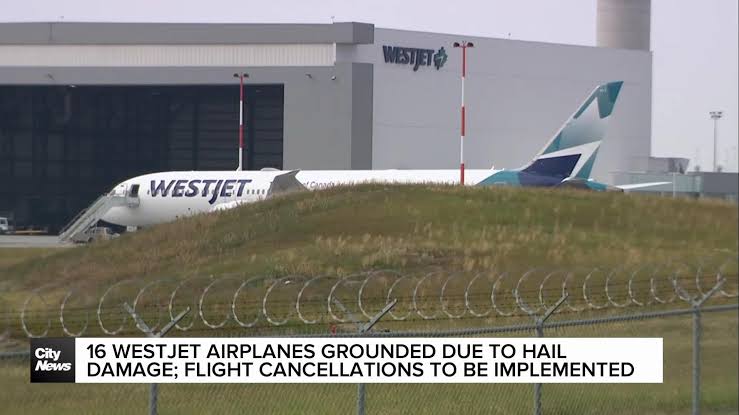WestJet says 10% of fleet grounded after Calgary pummelled by hail
WestJet says 16 of its planes have been grounded after a massive hailstorm hit Calgary earlier this week.
The Calgary-based airline says those aircraft — 10 per cent of its fleet — need substantial repairs and inspections before they can fly again.
The carrier also says 84 of its flights were cancelled Wednesday, with 106 cancelled Tuesday and 58 on Monday.The Calgary International Airport was pummeled by hail on Monday evening, forcing parts of its domestic terminal to close for repairs for an undetermined time.
A video taken by one traveller shows water pouring from the ceiling by a boarding gate, with chunks of what appear to be tile crashing to the ground.
A spokeswoman for Air Canada says its Calgary operations have returned to normal and it was able to schedule its largest planes to transport stranded passengers.
In August 2024, a severe hailstorm struck Calgary, Alberta, leading to significant disruptions across various sectors, notably aviation. WestJet Airlines, headquartered in Calgary, reported that approximately 10% of its fleet was grounded due to hail-inflicted damages. This incident not only underscored the vulnerabilities of airlines to extreme weather events but also highlighted the broader implications for the aviation industry and the communities they serve.
The Hailstorm’s Impact
Calgary, often referred to as the “hailstorm capital of Canada,” is situated within a region known as “Hailstorm Alley.” This area, extending from High River through Calgary to regions as far north as Edmonton, frequently experiences damaging hailstorms during the summer months. The August 2024 storm was particularly severe, with hailstones reaching sizes comparable to tennis balls, causing extensive damage to infrastructure, vehicles, and notably, aircraft.
WestJet’s Response
In the aftermath of the storm, WestJet conducted thorough inspections of its fleet to assess the extent of the damage. Approximately 10% of their aircraft were found to have sustained damage significant enough to necessitate grounding for repairs. The airline prioritized passenger safety, adhering to stringent maintenance protocols before returning any aircraft to service. This proactive approach, while essential, led to temporary reductions in flight availability and schedule adjustments.
Operational Challenges
The grounding of a portion of WestJet’s fleet presented several operational challenges:
Flight Cancellations and Delays: With fewer aircraft available, WestJet had to cancel or reschedule numerous flights, affecting thousands of passengers.
Passenger Accommodations: The airline worked diligently to rebook affected passengers on alternative flights and provided accommodations where necessary.
Financial Implications: The unexpected maintenance and repair costs, coupled with potential revenue losses from reduced flight operations, posed financial strains on the airline.
Broader Economic Impact
The hailstorm’s repercussions extended beyond WestJet:
Insurance Claims: The storm contributed to record-breaking insured losses in Canada for 2024, with total claims reaching approximately C$8.5 billion.
Local Economy: Calgary’s economy faced challenges as businesses dealt with property damages, and consumers curtailed spending amidst recovery efforts.
Climate Considerations
The increasing frequency and severity of such weather events have raised concerns about climate change’s role in exacerbating natural disasters. The 2024 hailstorm in Calgary became the second costliest disaster in Canadian history, causing approximately C$3 billion in insured losses in just over an hour. This trend underscores the need for industries, including aviation, to bolster resilience against climate-induced disruptions.
Future Preparedness
In light of these events, WestJet and other airlines are evaluating strategies to mitigate risks associated with extreme weather:
Infrastructure Enhancements: Investing in reinforced hangars and protective measures to shield aircraft from hail damage.
Operational Flexibility: Developing adaptable scheduling systems to accommodate sudden fleet reductions.
Collaborative Efforts: Engaging with meteorological agencies to improve forecasting and early warning systems, allowing for proactive measures.
Conclusion
The August 2024 hailstorm served as a stark reminder of nature’s unpredictability and the cascading effects such events can have on industries and communities. For WestJet, the incident highlighted the critical importance of preparedness, resilience, and adaptability in the face of climatic challenges. As weather patterns continue to evolve, a collective effort towards sustainable practices and robust infrastructure becomes imperative to safeguard against future disruptions.






